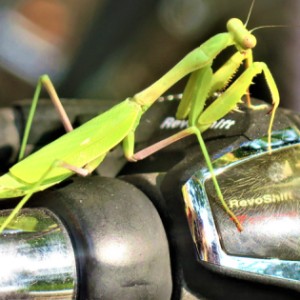Hey!
Can't you see I'm trying to pray here?
Extra: Our mantis prior to molting.
Earth matters
The authors concluded that the hot sun, low humidity and intense light of the Italian summer promoted the production of both brown ground vegetation and brown mantises. More moderate temperatures, higher humidity and low light intensity promoted green vegetation and mantises. In other words, climatic variables are a causal factor in mantis color change. But while sunlight and humidity can trigger a praying mantis to shift its color after a molt, this adaptation is likely a response to predation pressures. A brown mantis during the green summer (or a green mantis during the brownish fall) would be easier for a visual daytime predator like a bird to see.
Climate, plant color and hungry predators are all factors interacting and resulting in a brown or a green mantis. Through the observation of one insect we get a glimpse into the dynamic relationship of variables that are constantly interacting and influencing one another in our world. This question of mantis color can open our eyes to the immense complexity of the interconnected web of life that we’re a part of.


Comments
Sign in or get an account to comment.


